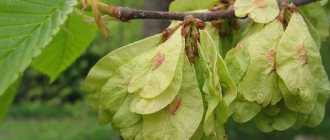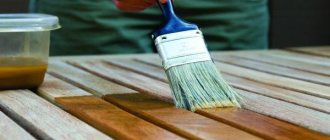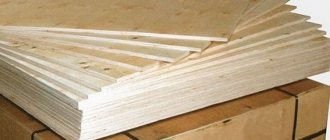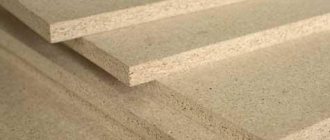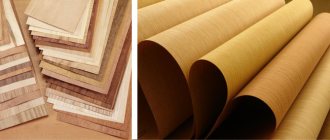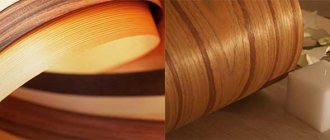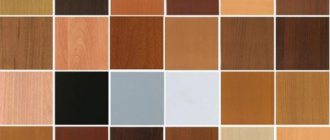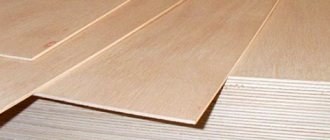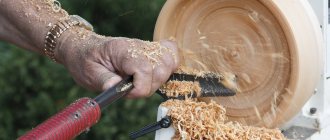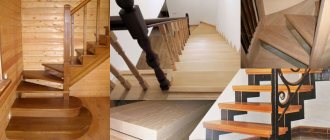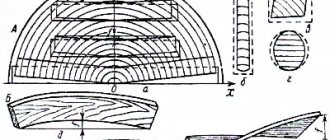WPC is the most modern type of wood composites, combining the advantages of wood and plastic and devoid of the disadvantages of natural wood.
More familiar predecessors to this material are chipboard, fiberboard and MDF, which consist of sawdust or shavings and a binder. They are cheaper than natural wood and in some respects surpass it in characteristics, which determines the main direction of their use.
However, they can hardly be called perfect, which served as the basis for new developments. The result is a new generation of innovative material with wide application.
What and how are they made from?
Wood-polymer composite (WPC) contains wood flour (or agricultural waste to reduce the cost of products), thermoplastic polymer and various modifiers (giving the finished product special properties). The percentage of the first two components depends on the manufacturer and class of material.
The cheapest option contains 30% polymer and 70% wood flour, which makes the material hydrophilic, less wear-resistant and more fragile. With an equal ratio (50/50), it is possible to obtain a material with optimal properties.
The content of 60% polymer and 40% flour affects the aesthetic qualities of the coating (externally, the decking looks not like a board, but like plastic), but at the same time it gives additional strength and resistance to environmental factors. The inclusion of chemical additives (modifiers) in the composition does not affect the environmental friendliness of the material, since their amount does not exceed 5%.
The manufacturing process is based on extrusion - a method of producing a product from a polymer by pressing it in molten form through the molding hole of a processing machine - an extruder. Less commonly used are injection molding and compression molding.
How to choose quality WPC decking
If you are offered an imported WPC decking board at a price below the market average, it is better not to take it. Usually these are products made either in China, or (even worse) in a garage on old equipment from who knows what. There are very good Chinese boards made of polymer-wood composite, but there are many more low-grade products. It’s easier to buy from companies with a proven reputation.
The desire to save money is understandable, but cheap fish...
When choosing composite decking, here's what to look for:
- The structure should be uniform with inclusions of wood fibers. There should not be areas with different surfaces.
- The lintels are of the same thickness, the edges are clear and even.
- The surface is free of cavities, castings and other defects.
- Look at the sides, front and bottom edges. There should be no pronounced waviness.
- Chamfers and grooves are at the same distance, the same depth.
- There should be no delaminations, crumbs, etc. on the cut.
- If you try to break off a small piece at the cut site, the WPC material should not even bend, let alone break and crumble.
If you have the opportunity, look at all the colors offered by the manufacturer. Normal companies should have light shades. This means that the wood used is normal. If the colors are only dark, bark and other waste are used instead of normal wood. But this is not the same material at all and no one guarantees its properties.
Technical and operational qualities
WPC materials are intended primarily for furnishing objects that are actively exposed to the external environment. When used in open sunlight, with high humidity and with significant temperature fluctuations, the composite board must have special properties.
The material characteristics presented below determine the long service life of the coating (from 15 to 50 years) even in extreme climates:
- wear resistance: resistance to abrasion and scratches, absence of splinters (even in areas of maximum traffic, the floor covering retains its original appearance);
- resistance to ultraviolet rays: does not fade or collapse;
- moisture resistance: do not swell, when drying the profile does not change shape;
- resistance to temperature changes in the range from minus 50 to plus 70 degrees;
- high strength: does not crack from impacts, withstands high loads;
- immunity to mold and pests;
- lack of special care and the need for additional coating and antiseptic treatments;
- the ability to restore material after severe contamination;
- resistance to aggressive solutions (alkali and acid);
- high fire resistance: self-ignition from a cigarette butt or spark is excluded, does not support combustion;
- convenient installation and dismantling: the fastening is well thought out, the profile can be sawed, drilled, bent;
- environmentally friendly (does not emit harmful substances) and recyclable (does not pollute the environment with waste);
- good thermal conductivity similar to wood: if you walk on the surface barefoot, you will not feel cold;
- high aesthetic qualities: has the aroma, texture and color of natural wood, there are many color and texture options.
Based on the characteristics of the material presented above, we can highlight the main advantages of WPC products over natural wood:
- high moisture resistance allows the material to be used even on the seashore;
- durability and practicality;
- lack of annual treatments and special care.
The only disadvantages that should be noted are the high cost and the risk of falling into the hands of an unscrupulous manufacturer.
Raw materials for the production of liquid wood
One of the advantages of WPC is its unpretentiousness to raw materials, which makes it possible to use almost any type of wood waste to obtain it:
- Sawdust.
- Woodchips.
- Wood screening.
- Wood flour and dust.
- Wood trimmings.
- Branches and twigs.
- Firewood.
- Gorbyl.
- Add up to 20% bark to the total volume of wood.
In the production of CSA, the following can also be used as additives:
- Seed husk.
- Straw.
- Agricultural biomass.
- Waste paper.
But there are also so-called semi-finished products for the production of WPC. The advantages of semi-finished products include cheaper transportation of raw materials to the place of production due to the higher density of the semi-finished product than sawdust. Also an advantage is the simplified technical process due to the exclusion of the wood drying process; the semi-finished product has acceptable humidity. Semi-finished products are crushed and sent to technology. Semi-finished products include:
- Ready pellets.
- Briquettes.
- Eurodrova.
The binder is polyvinyl chloride, polyethylene,
Distinctive features of WPC products
Wood-polymer composites can differ not only in the ratio of the main components, but also in the type of raw materials used. As a filler, in addition to wood flour, sunflower seed cake, rice husks, and waste paper can be used.
The binder thermoplastic polymer can be polyvinyl chloride, polypropylene or polyethylene. Each of them gives the finished product somewhat specific properties.
The boards differ in density (from 700 to 1200 kg/m3) and in structural strength (hollow and solid). They can be one-, two- or multi-layer. According to the method of surface treatment, surfaces can be sanded, embossed, printed, with a protective polymer layer applied, covered with paints and varnishes, lined with veneer or synthetic film and metallized. Also, often, a composite decking board has two different working surfaces: relief and textured wood.
Panels from most manufacturers have set dimensions in width and length. However, some Russian manufacturers are ready to accommodate consumers and offer products in individual sizes.
WPC facade board
The width of the facade board has the following options: 8-12 cm, 14-16 cm and 18-20 cm. The thickness of the panel can be from 1.0 to 2.1 cm. The length is 3, 4 or 6 meters. The terrace board differs primarily in thickness, which varies from 2.5 to 3-4 cm.
Types of WPC decking boards
There are several classifications of decking depending on the characteristic, but the main division distinguishes solid and hollow types of flooring. The first involves a solid composite without cells, while the second has empty compartments. This affects the strength of the material. Full-bodied is used in public places, for example, in summer cafes, on embankments and ferries. Hollow ones are more often used in private areas.
By flooring method
WPC boards are:
- Solid. The planks are equipped with a tongue and groove, which allows the products to be laid closer to each other. When it rains, water drains from them more slowly, which is why puddles will appear during intense rainfall. The advantages of this option are that small objects will not fall into the gap.
- With gaps. The distance between the slats is usually 1-3 mm, maybe more if the design requires it. Water flows into the cracks without lingering on the flooring itself. Advantages - even if the dimensions of the planks change during operation, this is not critical. The downside is that walking is not as comfortable as walking on a solid surface, especially in stiletto heels.
WPC decking board: profile
Hollow decking can be:
- Private profile. Such a board has 2 horizontal planes, between which there are jumpers that form cells. This type is more stable.
- Open profile. There is only one horizontal surface; at the bottom it is not reinforced with anything, but ends with jumpers. The planks are cheaper and are not designed for heavy loads.
The first option is preferable if people will walk on the flooring. If wall cladding is required, you can also use an open profile.
By type of surface
Regarding the type of surface, WPC boards are divided into:
- Imitating wood. Repetition of wood texture. Not deep enough to provide an anti-slip effect. It wears out quickly and has a higher price. However, it looks nobler and easier to clean. To clean it, just walk over it with a broom. Suitable for covering areas where people will walk barefoot or in soft shoes. Otherwise, it will quickly lose its attractive appearance.
- Velveteen. The surface is “riddled” with parallel grooves ranging from 1.5 to 6 mm wide. It is not slippery and takes much longer to wear than wood imitating materials. However, there is also a drawback - the labor-intensive cleaning process. You need something to remove debris from narrow crevices. Karcher is better than other methods.
- Cast. The cheapest type. He says that the manufacturer paid little attention to the production of decking and did not waste time on pre-sale preparation. It’s better not to choose this option, although the price is attractive.
The nuances of installing wood-polymer boards
According to professionals, installing a composite board is not difficult, but there are some nuances that should be taken into account. It is not recommended to install in sub-zero temperatures. If installation is carried out at low positive temperatures, then 2-3 days before the start of work, the boards should be outdoors for adaptation. For any coating, it is necessary to leave ventilation gaps both between the boards and from the surface to be coated.
When laying decking boards, be sure to prepare the surface - pour a monolithic slab, make a metal frame, or use point supports - paving slabs or concrete blocks laid on a leveled and compacted layer of sand.
Fastening is carried out on mounting logs, also made of WPC, the standard distance between the centers of the logs is 40 cm. To prevent the appearance of extraneous noise, you must remember to place rubber cushions under the logs. Direct contact with the soil is not allowed. The structure of the blind flooring must have a slight slope to allow precipitation to drain away.
Seamless fastening
When assembling, use the attached diagram and appropriate fasteners. The protrusion of the ends of the flooring after the outer joist should not exceed 2 cm; with regular load, a larger protrusion will create conditions for premature destruction of the structure. The decking is closed at the end with special plugs. It is forbidden to use a hammer to adjust the boards; a mallet is suitable for this purpose.
Seam fastening with clip
There are two installation methods for decking boards:
- suture (attachment to the joist with a clamp or clip; a seam of 5 to 10 mm is formed; acceptable when installing flooring outdoors without a canopy; it is simple);
- seamless (the board is attached to the joist directly with a self-tapping screw; the gap for thermal expansion of about 3 mm is adjusted using a special limiter; due to difficult drainage, it is used for closed terraces and indoors; it is highly aesthetic).
Failure to follow the manufacturer's installation recommendations significantly reduces the service life of the structure.
Results
Wood-polymer composites are new, high-tech materials that have excellent consumer characteristics and a lower price than natural wood. This allows the material to be used in various finishing works indoors or outdoors, as well as creating finishing for specific structures - yachts, piers, swimming pools, saunas and baths.
Due to the fact that WPCs appeared no more than 10 years ago, the demand for them is constantly growing at a fairly high cost, which is beyond the means of most consumers. Over time, there is a tendency for costs to decrease slightly through the discovery and adoption of more cost-effective technologies.
Manufacturers and estimated prices
There are often reviews on forums about “burning out” of WPC boards. In fact, we are talking about the natural phenomenon of a slight change in color under the influence of ultraviolet radiation. This happens once, a few days after installation, and subsequently the color remains unchanged. This is not an indicator of low quality and all manufacturers warn about this.
Today you can buy “liquid wood” (the material received this name due to its high plasticity) from Russian, Chinese and European manufacturers. They offer composites of different compositions and percentages of components, which inevitably affects the physical and aesthetic properties of the product.
Some of the brands that enjoy the trust of customers in 2017 are: Newwood (Russia), Holzdeck (Russia-Germany), Multideck (Russia), Ecodeck (Russia), Lignatek (Russia), Holzhof (Czech Republic), CM Decking (Sweden) , Grinder (Germany), Bruggan (Belgium), Mirradex (Malaysia), Legro (Hungary), DeckMayer (Russia), Werzalit (Germany), Sequoia Group (Austria-Russia-China).
Many factors influence the pricing of the finished product. Prices for wood-polymer boards start from 1500-1700 rubles. per 1 m2, with an average of around 2300 rubles. (1 linear meter will cost about 350 rubles).
Production of liquid wood - from the lips of production workers
Production technology
WPC production begins from a raw material storage warehouse. Large volumes of raw materials are transported to this warehouse. From the warehouse, wood processing waste and firewood are supplied to a drum or disk crusher for processing into industrial chips. In industry, drum crushers are more popular due to their ease of operation and maintenance.
Process chips are too large for further drying, so the chips are further crushed into chips, which then enter the drying drum. The regrinding operation is carried out in a hammer mill.
Drying of chips in a drying drum is carried out at an inlet temperature of 300 degrees in summer and up to 550 degrees in winter. The temperature at the outlet of the drum ranges from 50 to 70 degrees Celsius. The wood drying area is serviced by one operator who monitors the uniform supply of raw materials, temperature conditions and the proper operation of all mechanisms. Drying of chips is carried out to a moisture content of 8 - 12%.
Next, the dry wood pulp is again crushed to give the particles a more uniform size. The hammer mill is equipped with a sieve with a round mesh and a single hole diameter of 5 - 7 mm.
After additional grinding, the chips are fed into a hopper where they are mixed with hard plastic. Passing through the extruder, the material is heated, mixed and extruded through a mold, also called a die. Now it is only necessary to soak the material until it is completely cured. This video will tell you better about the operation of the extruder, but instead of plastic there is a mixture of wood and polymer:
Consumption rates for the production of one cubic meter of WPC
Unambiguous and accurate consumption rates for WPC can be obtained by working out the production technology and setting up the line to produce wood polymers of a certain density, and the density of the composite can range from 1000 to 1500 kg/cubic meter. With such a density, liquid wood loses a number of consumer properties, which is why it is made hollow inside.
- Wood - 2.5 cubic meters with a moisture content of 6-10%
- Wood - 2.7 cubic meters with a moisture content of more than 30%.
- Polymer - 200 kilograms.
- Additives - up to 100 kilograms.
